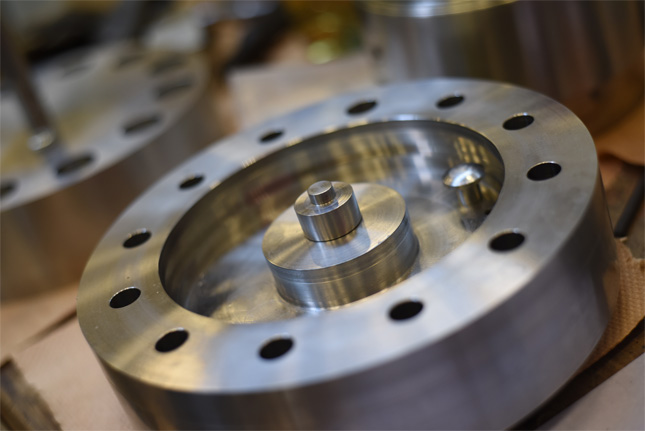LMR laboratory
Laboratory of Mechanical Engineering and Rheology
The Laboratory of Mechanical Engineering and Rheology (LMR EA 2640) is a research laboratory affiliated to Tours François Rabelais University and jointly accredited with the INSA Centre Val de Loire.
Scientific areas of interest
The laboratory's research activities are all carried out with a single scientific theme in mind – Mechanical characterisation of materials and structural dynamics – which is organised into 3 scientific areas of interest:
- Characterisation and modelling of materials
- Material fatigue
- Structural vibrations
The LMR has partnered up with several research centres, in close liaison with companies and competitiveness clusters in the region, including Elastopôle:
- Study and Research Center for Elastomer Materials (CERMEL).
- Study and Research Center in Cutting Tools (CEROC).
- Study and Technological Research Center en Microelectronics (CERTEM and CERTEM plus).
- Study and Research Center for SENSoriel Technologies (CERTESENS).
There are 6 professors, 13 lecturers – 3 of whom have an HDR (accreditation to supervise research) – 1 research engineer, 4 temporary research and teaching staff, 15 PhD students and 2 technicians at the LMR. The director is N. Ranganathan (professor at Polytech Tours). The deputy directors are C. Richard (professor at Polytech Tours) and J-M. Mencik (professor at the INSA Centre Val de Loire).

© INSA CVL
3 of the LMR’s professors, 6 lecturers and the research engineer are all based on the INSA site. The research themes addressed all concern the areas of interest “Characterisation and modelling of materials” and “Structural vibrations”.
Making up the team working on the characterisation and modelling of materials are a university professor, three lecturers and a research engineer. This team studies the chain running from development to use, along the way touching on experimental characterisations and numerical modelling by FEM, as well as materials with complex behaviour such as polymers that may or may not be reinforced by microscale or nanoscale fillers. The scientific themes covered include:
- Experimental and numerical study of the behaviour of explosive polymers with a polymer matrix (3 theses defended, 1 thesis underway, 8 publications in international peer-reviewed journals, several contracts with the CEA)
- Behaviour, rupture, damage and fatigue of elastomers (over 10 publications in international peer-reviewed journals)
- Recycling of elastomers (1 co-supervised thesis underway, 1 postdoc underway, 1 regional project underway)
- Properties of polymer matrix nanocomposites (1 thesis defended, 1 thesis underway, 3 international publications in peer-reviewed journals)
- Study on the ageing of the human skin: correlation between mechanical and ultrasound measures (1 Regional project, 1 postdoc underway, 1 Master underway)
The research activities being carried out on the "Vibrations" subject are aimed at numerical prediction and experimental identification of the dynamic behaviour of complex structures. They are as follows:
- Vibroacoustics & wave propagation
This activity concerns the development of effective numerical models that are geared towards the problems of vibrations under medium frequencies of elastic and multiphysical systems (fluid-structures or material-structures). Recent work on the "Wave Finite Element" (WFE) method has been conducted in this regard to describe the vibratory and vibroacoustic behaviour of periodic complex structures (e.g. aircraft fuselage), with much shorter computing times than is possible with conventional techniques (finite elements and modal synthesis).
- Diagnosis & vibratory surveillance
This activity concerns the in situ experimental identification of systems' dynamic parameters with a view to tracking them over time. The aim is to develop adapted filtering techniques for eliminating artifacts in play. "Subspace" methods are examined to this end. By combining these methods with the finite element method, it is possible to locate the defects in a complex structure. This original, "subspace fitting" approach is under study.
- Nonlinear dynamics with uncertainties & robust design
Mechanical design has powerful design tools at its disposal that can predict the dynamic behaviour of complex mechanical systems and structures. However, in order to ensure the vibratory levels laid down by specifications, it is becoming increasingly necessary to factor in both nonlinearity and uncertainty. In this context, the first objective of this activity is to set up methods and models for factoring uncertainty into the dynamic behaviour of nonlinear systems. The second objective is to implement a robust design approach aimed at optimising the design parameters by using the methods developed with the first objective in mind. Current efforts are making use of probabilistic approaches and concentrating more particularly on studying stability and the vibratory levels of such friction systems as brake or clutch systems.
Find out more…
Contact us
- Jean-Mathieu Mencik, professeur INSA et LMR
Tél : +33 (0)2 54 55 84 65
Email : jean-mathieu.mencik@insa-cvl.fr - Research department
Tél : +33 (0)2 48 48 40 31 / +33 (0)2 48 48 40 55
Email : direction-recherche-valorisation@listes.insa-cvl.fr

